When it comes to kitchen knives, Japanese cutlery generally falls into two broad categories: traditional Japanese knives (和包丁) and Western style kitchen knives (洋包丁).
Each has its own characteristics and ideal uses. In fact, if you’ve ever searched western vs japanese knives, you’ve likely seen plenty of lively debates comparing these two styles!
But fear not—below we break down the key differences and introduce you to the world of Western style Japanese knives in a friendly, easy-to-understand way.
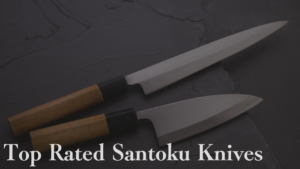
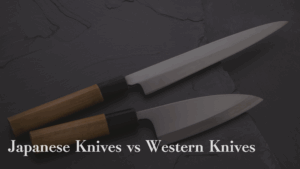
Japanese vs Western Knives: What’s the Difference?
Before diving into the knives themselves, let’s quickly compare Japanese and Western knives.
There are entire countless threads dedicated to Western vs Japanese knives, but here’s a simple summary of how they typically differ:
| Feature | Japanese Knives (和包丁) | Western Knives (洋包丁) |
|---|---|---|
| Blade shape | Predominantly single-bevel edge (片刃) | Predominantly double-bevel edge (両刃) |
| Types | Many specialized types for each purpose | Many knives are highly versatile |
| Steel | High-carbon steel for superb sharpness | Often stainless or softer steel |
| Production | Includes traditional honyaki (single steel) and kasumi (laminated) forging methods | Typically forged from a single piece of steel |
| Maintenance | Requires careful upkeep to prevent rust or damage | Less prone to rust, easier day-to-day maintenance |
In short, Japanese knives tend to prioritize precision and delicacy, while Western knives are often designed for more robust tasks like chopping through meat and bone. Western style Japanese knives combine the best of both worlds: they are made by Japanese craftsmen but in the style of Western knives, giving you durability and versatility with Japanese quality. (No wonder many chefs consider a well-made gyuto to be among the best western chef knife options available!)
All-Purpose Western Knives
Western-style kitchen knives that are considered “all-purpose” can handle a variety of ingredients. In traditional Japanese knives, the all-rounder is the santoku包丁, but in the Western category the two most common multipurpose knives are the gyuto and the petty knife. Let’s look at each:
Gyuto (Chef’s Knife) – The Multipurpose Workhorse
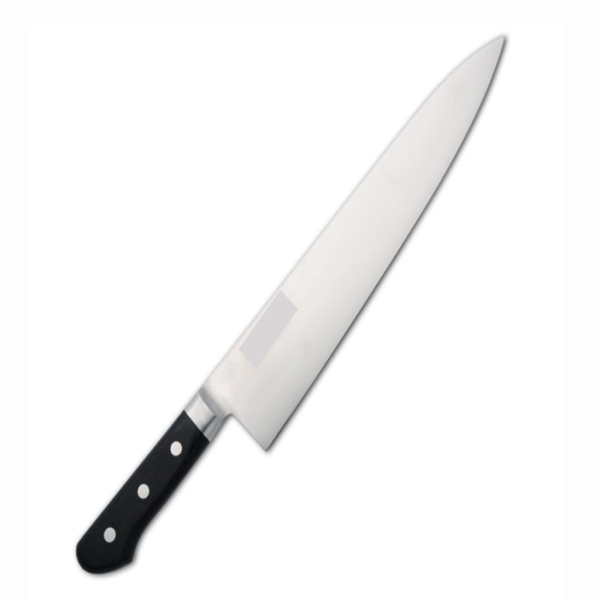
The gyuto包丁 is essentially the Japanese take on the classic Western chef’s knife. In fact, “gyuto” literally means “beef sword” because it was originally used for cutting meat, and it corresponds to the European/American chef’s knife in shape and function. Over time it has become a versatile go-to blade for many cooks.
- Blade Shape: The gyuto has a slightly pointed tip and a gently curved edge along the entire blade. This curved profile allows for various cutting techniques—push cuts, pull cuts, even a rocking chop—making it easy to adapt to different ingredients and cutting styles.
- Uses: Despite the name (which comes from its origin as a knife for cutting beef), a gyuto’s real charm is its all-around utility. It can handle a wide range of foods including meat, fish, and vegetables. Its longer blade excels at slicing through steaks or breaking down large roasts, but it’s equally adept at dicing vegetables or filleting fish. This makes it suitable for everything from European cuisine to multi-national cooking.
- Blade Length & Weight: Gyuto knives typically range from about 18cm up to 24cm in blade length. They tend to be medium to slightly heavy in weight. That added heft provides stability and power when cutting tougher ingredients like big cuts of meat or harder root vegetables.
- Distinct Feel: Thanks to the curved blade, you can use a rocking motion on the cutting board for quick, continuous chopping. The gyuto feels lively and agile in use. By using a combination of pull cuts and push cuts, you can slice foods cleanly without crushing them, leaving smooth surfaces on your ingredients.
In essence, a gyuto is a longer, more versatile counterpart to the Japanese santoku. It’s a universal chef’s knife that many professional chefs and home cooks alike swear by.
Petty Knife (Small Utility Knife) – The Indispensable Helper
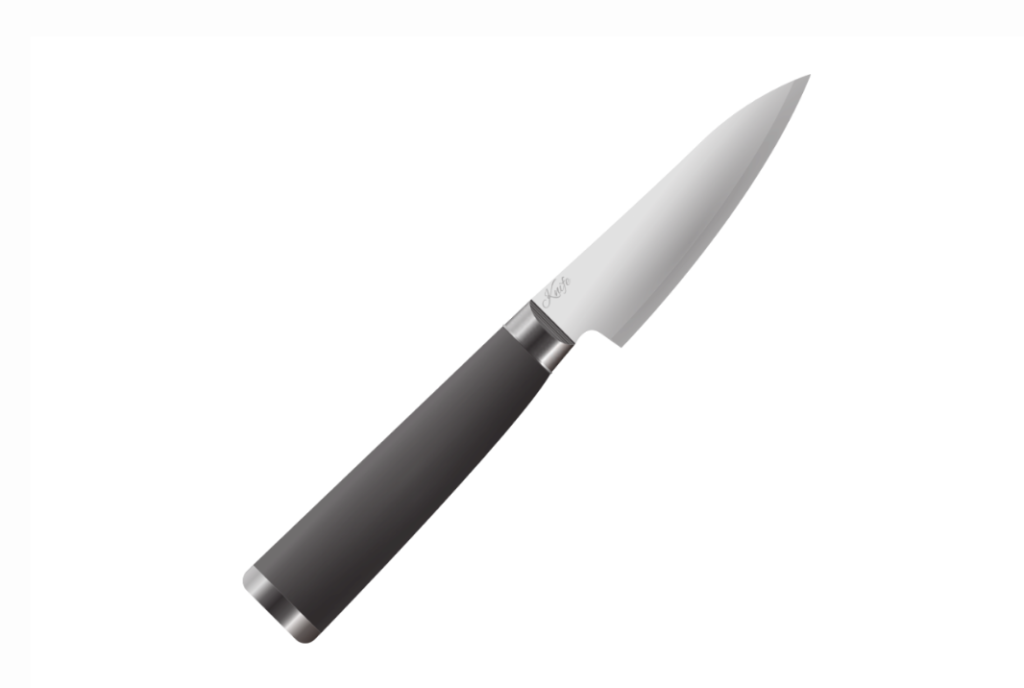
The petty knife (ペティナイフ) is a small, lightweight utility knife that is incredibly handy for fine work. Because it’s so nimble and easy to handle, the petty knife is an indispensable supporting player in the kitchen, perfect for precise tasks and intricate garnish work.
- Blade Shape: Petty knives have short blades, usually around 10–15 cm (4–6 inches) in length. The blade is slim and often tapers to a very sharp, pointed tip. Thanks to its slim and compact build, it allows for great control in detailed tasks right in your hand.
- Uses: This knife shines in delicate tasks that require precision. It’s ideal for peeling fruits and vegetables, trimming fat, carving decorative cuts, and other intricate prep work. Any job that’s a bit too awkward for a big chef’s knife—like peeling an apple or de-veining shrimp—is where a petty knife excels. You can smoothly handle small ingredients and detailed work that would be hard with a large blade.
- Blade Length & Weight: Most petty knives have a blade in the 8–15 cm range (with 10–15 cm being common) and are extremely lightweight. Their small size and light weight make them easy to maneuver, so even cooks with smaller hands (or those who might find large knives intimidating) can use them comfortably. This also makes it a great knife for beginners or anyone who values agility.
- Distinct Feel: The compact size of a petty knife gives it superb maneuverability. It’s easy to control close to your hands, allowing you to make very precise cuts at delicate angles. Whether you’re peeling fruit, segmenting an orange, or cutting decorative garnishes, the petty knife lets you achieve a clean, beautiful result without much effort. You’ll find it offers accuracy and finesse, making your prep work look pro-level.
Yōsaigiri (Hybrid Vegetable Knife) – A Western-Style Nakiri
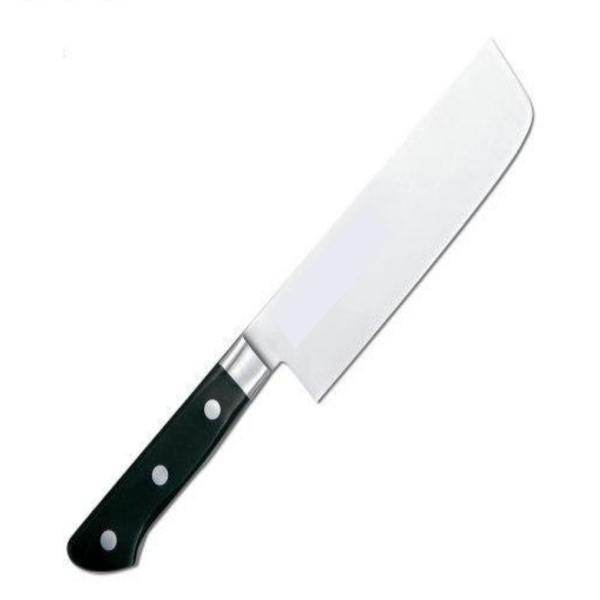
The yōsaigiri (洋菜切) is a specialized vegetable chopping knife that blends Japanese and Western design elements.
Think of it as a hybrid between the traditional Japanese nakiri (vegetable knife) and a Western knife. It’s purpose-built for vegetable prep, offering the best of both worlds for home cooks and pros who do a lot of veggie chopping.
- Blade Shape: The yōsaigiri features a broad, rectangular blade tip much like a Japanese nakiri, which gives it a flat edge profile ideal for chopping. However, it incorporates Western design philosophy in its construction: most yōsaigiri knives are double-beveled (sharpened on both sides) and often sport a Western-style handle. The blade is usually a bit thicker and sturdier than a classic nakiri. In short, it has a straight edge that lies flush on the cutting board for easy chopping, combined with a handle shape and blade heft borrowed from Western knives.
- Uses: As you might guess, this knife is all about vegetables. It’s perfect for slicing, dicing, and chopping veggies of all kinds. From shredding large leafy cabbages or halving a head of lettuce, to cutting carrots and daikon radishes into rounds or matchsticks, a yōsaigiri makes quick work of everyday vegetable prep. Its squared-off tip and straight edge let you do rapid up-and-down chopping (that satisfying “tap tap tap” motion) without needing to angle the blade. It’s also great for fine slicing like julienning and mincing herbs.
- Blade Length & Weight: Yōsaigiri blades are typically in the mid-size range—around 16–18 cm (6–7 inches) long. Thanks to the Western-style handle and construction, many models strike a nice balance in weight: they have a bit of heft for stability but remain well-balanced. Some designs might be slightly heavier than a traditional nakiri due to the thicker blade, but the comfortable grip makes it easy to control. Overall, it’s designed to feel solid yet maneuverable.
- Distinct Feel: One of the joys of using a yōsaigiri is how effortlessly you can do continuous chopping. Because it inherits the nakiri’s flat edge, you can rapidly chop veggies by moving the knife straight up and down, making tasks like creating thin strips of cabbage (for coleslaw or stir-fries) a breeze. The broad blade also lets you scoop up your chopped veggies easily for transferring to a pot or bowl. Meanwhile, the Western-style handle gives you a familiar, secure grip, allowing you to cut quickly and efficiently with confidence. Being double-edged, it’s also simpler to sharpen and maintain compared to single-bevel Japanese knives. It’s a knife equally at home in preparing Japanese dishes or Western cuisine.
In summary, the yōsaigiri is a hybrid vegetable knife that combines the ease-of-use of a Japanese veggie knife with the grip and build of a Western knife.
It’s a versatile tool that can handle heavy daily veggie chopping from home kitchens to professional settings. If you love cooking with vegetables, this knife brings together the best features of both styles to make prep work faster and more enjoyable.
Knives for Cutting Meat & Fish
In the all-purpose section we mentioned the gyuto as a great knife for cutting meat. Now let’s look at a few Western-style knives that are more specialized for meat or fish prep.
These include the slicing/carving knife known as the sujihiki, the boning knife known as honesuki, and a heavy-duty hybrid knife called the yo-deba. Each of these knives has a specific role when it comes to butchery and fish processing.
Sujihiki (Slicing/Carving Knife) – The Precision Slicer
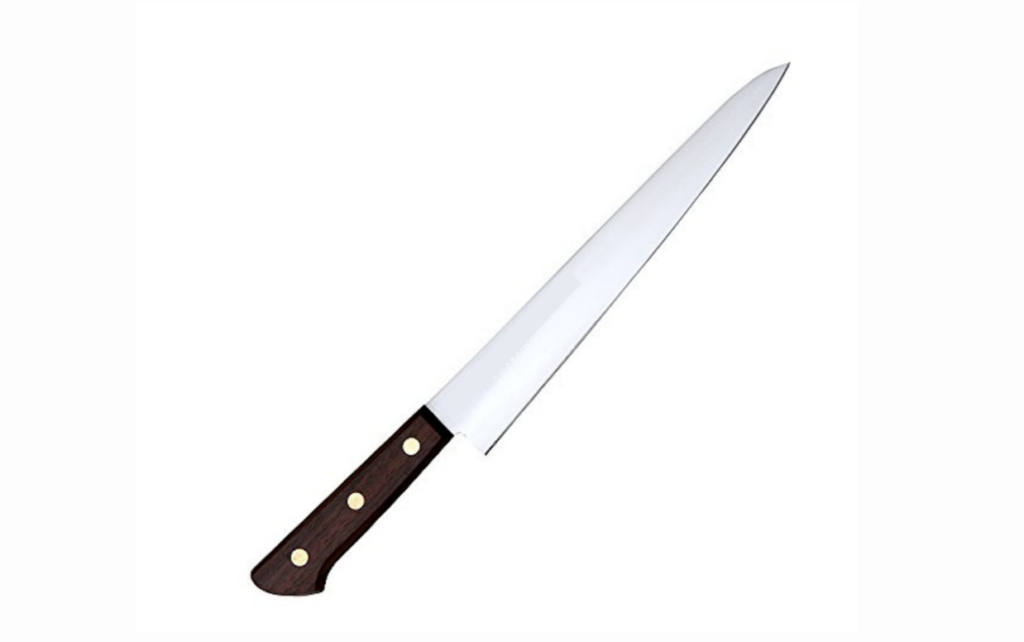
The sujihiki包丁 is a long, slender knife that is the Japanese version of a Western slicing or carving knife. Influenced by Western designs, this knife is purpose-built for smoothly slicing meat and trimming connective tissue or fat with precision. It’s often the knife you reach for when you want perfectly thin, even slices of roast or fish fillet.
- Blade Shape: Sujihiki knives have a notably long and narrow blade profile. The blade length is often in the 24–30 cm range (9–12 inches), tapering gradually to a sharp point. The edge is usually very straight (minimal curvature) and of course double-beveled. Thanks to its long, razor-sharp blade, the sujihiki can make long drawing cuts through meat. Its slender tip and profile allow it to slide precisely along sinew or between layers of meat and fat. In short, it’s like a Japanese fillet knife or carving knife with a super-sharp edge.
- Uses: The sujihiki is used primarily for meat preparation and slicing tasks. It’s the ideal knife for trimming silverskin, removing fat, and slicing cooked meats. For example, you’d use a sujihiki to remove the tough sinew from a beef tenderloin, to carve a roast beef or turkey into thin, uniform slices, or to cut a large fillet of fish into sashimi slices. It’s all about long, clean cuts. The sujihiki’s length lets you cut through a whole roast in one draw, which means less sawing back and forth and a cleaner cut surface (great for presentation!). Some chefs also use it to skin large fish or even to portion raw meat with precision.
- Blade Length & Weight: Common sujihiki blades run around 25–30 cm long, yet because they are narrow, these knives are relatively lightweight for their size. The long blade allows you to make one smooth pulling stroke to slice, which reduces friction and produces beautifully smooth cut surfaces. Despite the length, the slim design means it’s not too heavy; you can handle it fairly easily once you get used to the length.
- Distinct Feel: Using a sujihiki feels different from using a regular chef’s knife. The long, thin blade glides through protein with very little resistance, especially when doing a pulling slice (drawing the knife toward you in one motion). It cuts without tearing or crushing fibers, which is why the slices of meat come out so clean. In meat cookery, this is a huge advantage: you can trim away sinew and membranes very neatly and produce paper-thin slices of, say, smoked ham or roast beef with ease. Once you get the hang of it, you’ll find that even if you’re not a professional chef, a sujihiki lets you achieve restaurant-quality presentation for your roasts and fillets.
Overall, the sujihiki is the “expert” knife for meat slicing and prepping. From trimming raw meat to carving cooked steaks, this Western-style Japanese knife excels in any task that demands long, precise cuts.
It’s truly a meat lover’s best friend in the kitchen, enabling you to elevate the look and texture of your dishes.
Honesuki (Boning Knife) – The Bone Trimmer
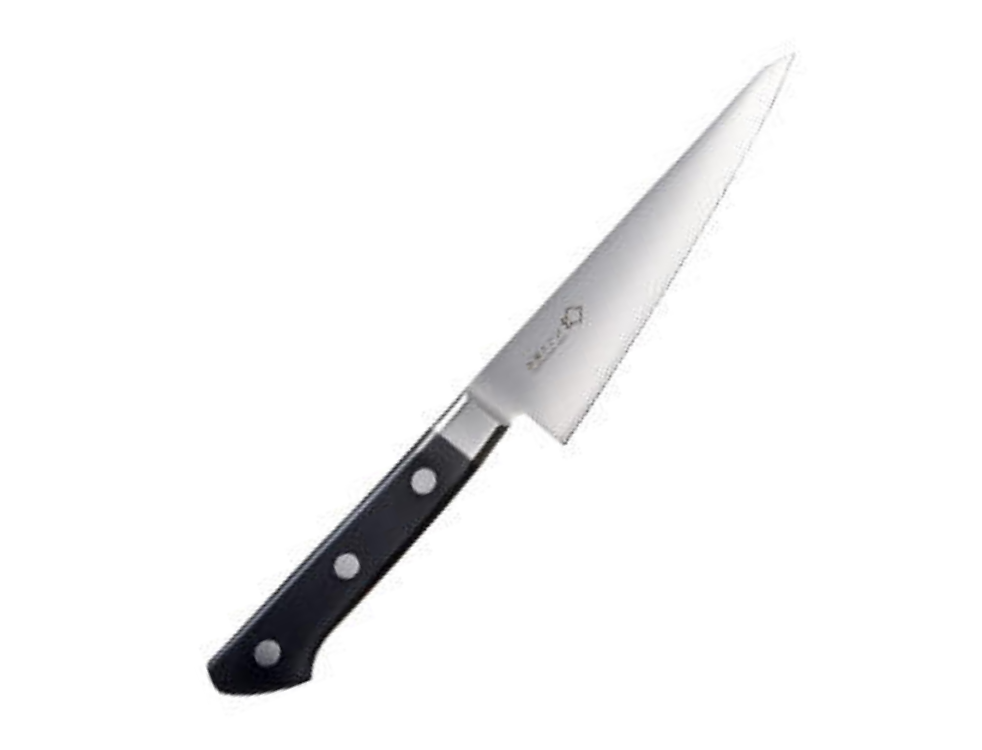
The honesuki包丁 is a Japanese boning knife specialized for breaking down poultry and cutting meat off the bone.
It’s actually considered a type of Japanese knife, but it’s often included in Western-style sets because its function is similar to Western boning knives. If you’ve ever wanted to efficiently debone a chicken or fillet a fish while leaving minimal waste, the honesuki is the blade for the job.
- Blade Shape: Honesuki knives typically have a short, triangular blade with a sharply pointed tip. The blade often curves subtly from the base to the tip. Uniquely, honesuki can come in single-bevel or double-bevel versions, but in either case the tip is very acute and the design allows you to easily insert the blade into tight spaces between bone and flesh. The blade is usually fairly thin and narrow, which gives you great control in small areas and helps maneuver around joints.
- Uses: The honesuki is all about separating meat from bone. It’s perfect for tasks like boning out a chicken (removing the meat cleanly from the carcass or cutting through the joints), filleting fish by working along the backbone, or trimming fat and sinew in hard-to-reach spots. Whenever you need to make precise cuts along bones—whether you’re taking the breasts off a whole chicken, removing ribs from a pork chop, or cleaning up a big fish—this knife is ideal. It excels at any butchery task that requires delicacy and accuracy to avoid wasting good meat.
- Blade Length & Weight: Honesuki blades are generally on the shorter side, typically around 12–18 cm (5–7 inches). They are also quite lightweight compared to most other knives, which makes sense since you often hold it in various angles and orientations to work around bones. The compact, light design means you can change direction easily and make controlled cuts close to your hands. Its shorter, narrow blade allows you to apply pressure at tricky angles without the knife feeling unwieldy.
- Distinct Feel: Using a honesuki feels precise and efficient. The sharp pointed tip can get into the tiniest gaps, and the sturdy yet thin blade lets you follow along bones with confidence. Unlike a big chef’s knife which would be cumbersome for deboning, the honesuki gives you surgeon-like control. You can make short, exact cuts even in spots that a larger knife could never reach. This precision means you’ll remove what you want (meat) and leave behind what you don’t (bone, gristle), improving yield and presentation. Mastering the honesuki elevates your butchery game—allowing you to break down poultry or fish in a way that yields beautiful, clean pieces of meat ready for cooking. It’s a knife that, once you’re skilled with it, empowers you to create professional-quality results in both Japanese and Western dishes that involve delicate meat prep.
In summary, the honesuki is a highly specialized knife for processing meat and fish with minimal waste and maximum efficiency.
It’s the trusty tool for chefs and home cooks who often find themselves deboning, trimming, or filleting. From restaurant kitchens to home cooking, this boning knife is valued for how it makes a difficult job easier and more precise.
Yo-Deba (Western Deba Knife) – The Heavy-Duty Butchery Blade
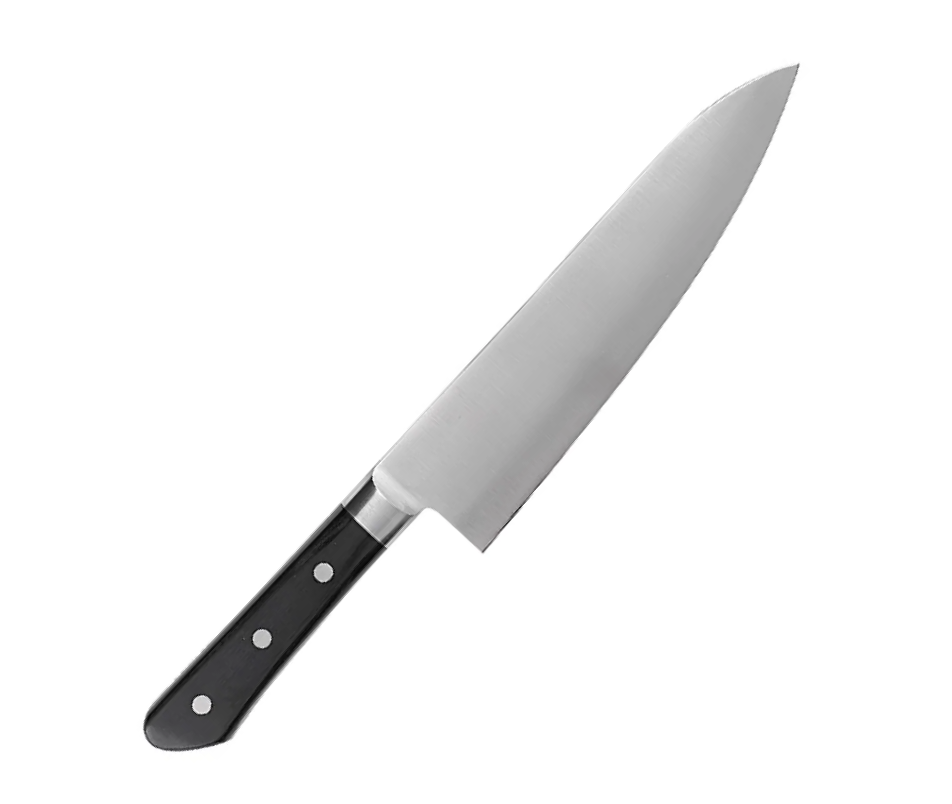
The yo-deba (洋出刃) is a heavyweight contender in the Western-style Japanese knife lineup. It’s essentially a hybrid of the traditional Japanese deba (a thick, heavy knife used for filleting fish and chopping through small bones) and a Western-style knife.
The yo-deba retains the deba’s brute strength but adds a double-edged blade and Western handle for versatility. If you need to do some serious butchery on fish or meat, the yo-deba is built for the task.
- Blade Shape: Much like a classic Japanese deba, a yo-deba has a thick, very sturdy blade. The blade is wide at the tip and quite thick at the heel (the part of the blade closest to the handle), then it tapers a bit toward the tip. Many yo-deba knives are double-beveled (unlike traditional single-bevel deba) and sport Western-style handles. The tip of the blade is broad and strong, while the base is extremely thick and tough. This design gives it the power to chop through fish heads or poultry bones, while the slight taper allows for smoother cutting when needed.
- Uses: The primary uses of a yo-deba overlap with those of a traditional deba: breaking down whole fish (like beheading and cutting through fish bones) and other heavy-duty butchering tasks. It’s the knife you’d use for the “power jobs” in filleting, such as cutting through the spine of a fish or segmenting a large fish into fillets. What sets the yo-deba apart is that it’s also designed to handle some Western butchery tasks—so you could use it on meat with bones as well. For instance, if you need to chop up a whole chicken or section a rack of ribs, a yo-deba can take it on. It’s characterized by a versatility in handling both fish and meat bone work, making it a kind of multi-purpose heavy chopper.
- Blade Length & Weight: Yo-deba blades are usually medium length, around 15–18 cm (6–7 inches), which is a bit shorter than some traditional deba knives. However, they are thick and hefty. There’s significant weight to this knife—when you pick it up, it feels solid and powerful. Thanks to the Western handle and double-edge, despite the weight it’s easier to grip and control for most users (right or left-handed). The design makes sure you can comfortably apply force and leverage. Essentially, it’s heavy where it counts (the blade) but manageable in the hand.
- Distinct Feel: The yo-deba carries the heft you need to power through tough cutting tasks. You can literally feel its robustness when you use it to chop through fish bones or chicken joints—the weight of the blade does a lot of the work for you. At the same time, the double bevel edge and familiar handle style mean it doesn’t require specialized technique to use; both lefties and righties can wield it with ease, and it feels more natural to those accustomed to Western knives. Compared to a traditional deba, the yo-deba is a bit more forgiving and versatile. It’s easier to maintain (since you sharpen it like any double-edged knife) and you can use it in more situations without switching tools. People appreciate that it blends the bone-splitting power of a deba with the user-friendly nature of Western knives. It’s handy across Japanese and Western cooking – anywhere you need serious chopping muscle.
The yo-deba is basically a fusion of the “thick, bone-capable blade” of a deba with Western styling. In today’s diverse kitchens where you might go from filleting a fish to trimming a rack of lamb, a yo-deba comes in handy for smoothly handling any bone-in cuts.
It’s an ideal knife for cooks who want to efficiently process meat or fish at home with a single, reliable tool.
Cleaver – The Heavyweight Bone Chopper

The cleaver (クレーバー包丁) is a classic Western-style knife known for its massive blade. This is the knife that looks like a small hatchet or a butcher’s axe, and it’s purpose-built for hacking through bones and very large, tough ingredients. A cleaver isn’t commonly used for everyday cooking in most home kitchens, but in butchery and certain cuisines (and outdoor cooking) it’s a superstar.
- Blade Shape: Cleavers have a large, rectangular blade profile. The blade is extremely broad and thick, giving it substantial weight. The cutting edge is usually straight or only slightly curved. One look at a cleaver and you’ll notice how thick the spine (back of the blade) is—that thickness is what lends it the strength to crack through bone. The handle is typically designed for a secure grip because you’ll be swinging or chopping hard with this knife; it often has a shape that lets you wrap your hand around firmly to deliver force.
- Uses: The cleaver’s main job is demolition, in a sense. It’s primarily used to break down large cuts of meat and to chop through bones. If a butcher is splitting a side of pork or hacking a whole chicken into parts (bones and all), they’ll likely reach for a cleaver. It can split beef bones, chop through ribs, or cut large root vegetables or squash with tough rinds in one blow. In some cases, people also use cleavers in outdoor cooking or camping when they need to, say, chop up game or cut through dense vegetables for a stew over the campfire. It’s overkill for most standard home cooking tasks, which is why you see it more in professional butcher shops or restaurant kitchens specializing in meat.
- Blade Length & Weight: Cleaver blades can vary, but many are around 15–20 cm long (6–8 inches). The defining feature, however, is the blade’s mass. A good cleaver is very heavy—some can weigh close to 1 kg (over 2 lbs). The blade is not only long but also tall (edge to spine) and thick. All that metal adds weight, and that weight is exactly what helps the cleaver chop with such power. When you swing a heavy cleaver down on a bone, the momentum and weight help drive it through. The downside is that weight can be tiring to handle, but since cleavers are meant for short powerful chops (not long prep sessions), it usually isn’t a big issue.
- Distinct Feel: Using a cleaver is nothing like using a chef’s knife. It’s more akin to using an axe. You don’t do fine control or delicate slicing with a cleaver—you do powerful chops. The cleaver excels in sheer cutting and crushing power; for example, you might raise it up and bring it down in one forceful motion to split a bone. It requires strength (and caution!) to use, and it’s intended for robust actions that you’d never attempt with another knife. With a proper cleaver, thick bones or hard joints can be dispatched cleanly in one or two whacks. The trade-off is that it’s not precise and certainly not for fine dicing or slicing. Also, keep in mind that sharpening a cleaver or maintaining it can take a bit more work, simply because of its size and because you may chip or dull it by hitting very hard materials. Some cleavers even have a hole near the spine so you can hang them up—a nod to their common use in butcher shops where they’re taken on and off the wall frequently.
A cleaver is a highly specialized bone-cutting knife that uses its weight to do the work. It’s a reliable friend in professional butchery or any scenario where pure power is needed to process big, tough ingredients. While not everyone needs a cleaver in the kitchen, if you do find yourself needing to break down large cuts or enjoy outdoor culinary adventures, a cleaver can be an immensely satisfying tool to wield.
Other Specialized Knives
Beyond the general-purpose and meat-focused knives, there are a few other specialized Western knives worth mentioning. These are designed for very specific tasks and can be great additions to your kitchen arsenal if you often find yourself in these scenarios. Here we’ll discuss the bread knife, and the frozen food knife.
Bread Knife – The Serrated Slicer
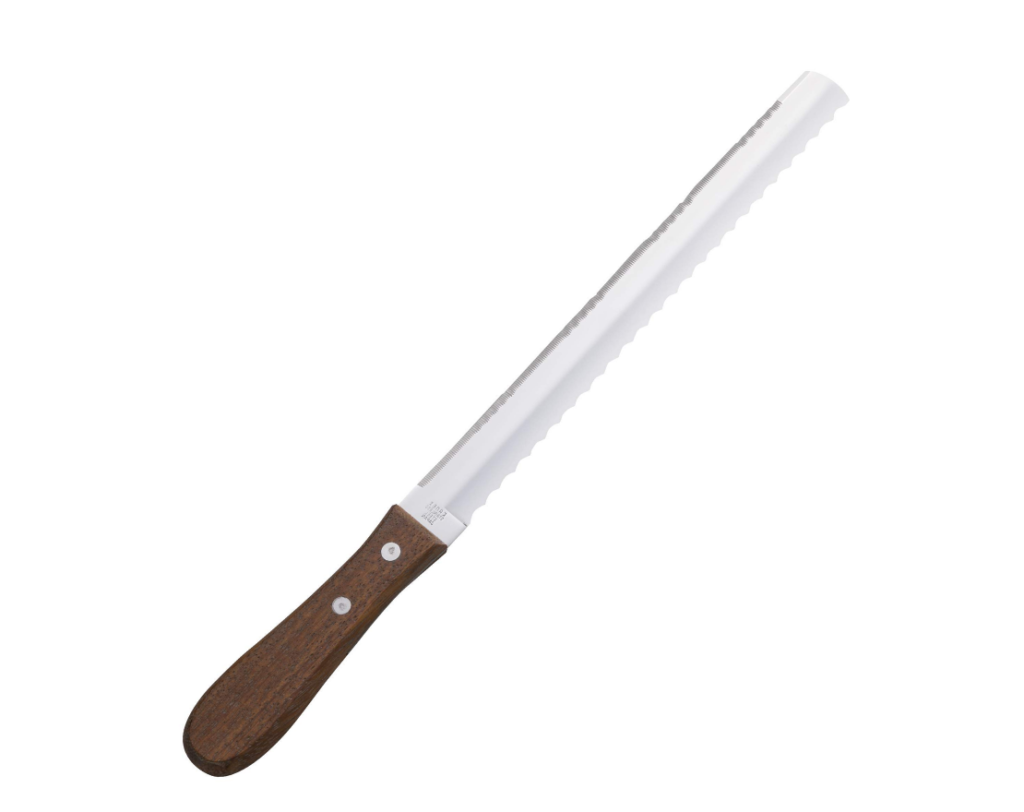
The bread knife (パン切り包丁) is a long, serrated knife designed specifically for slicing bread and other baked goods. If you’ve ever tried to cut a loaf of crusty bread with a regular knife, you know how it can squash the bread or slide off the hard crust. A bread knife solves that with its saw-like edge, allowing you to slice through without crushing. It’s a must-have for anyone who bakes or buys whole loaves.
- Blade Shape: The most notable feature of a bread knife is the serrated edge – those “wave-like” or scalloped teeth along the blade. This wavy, saw-tooth blade is its biggest distinction. The blade is usually somewhat thin and quite long, often with a straight profile (no significant curve). The serrations grip and tear through tough crusts while gently slicing through soft interiors. Bread knives typically have a long blade to accommodate large loaves and a slight flexibility can sometimes be present, though many are fairly rigid.
- Uses: A bread knife is used primarily for cutting bread (no surprise there!), including everything from soft sandwich bread to crusty artisan loaves. It lets you cut through a hard crust (the outside of the bread) without the blade skidding off, and it cuts through the soft crumb (the inside) without compressing it. This means you get neat slices without squashing the loaf. Bread knives are also great for other delicate tasks: slicing cakes (especially those with soft, airy crumb) or cutting pastries like croissants, bagels, and crusty baguettes. Essentially, any food with a hard exterior and soft interior is a good candidate for a bread knife. Some people even use bread knives for carving very soft fruits (like a ripe tomato) or for slicing boneless roasts if they don’t have a serrated slicer—though its primary design is for bread and baked goods.
- Blade Length & Weight: Bread knives are usually on the longer side, commonly around 20–25 cm (8–10 inches) in length. They need that length to comfortably saw through a big loaf in a few strokes. The blade is not typically very wide or thick; it’s comparatively slender (aside from the serrations). Bread knives are often quite lightweight, which is a plus because you might be slicing multiple pieces in a row. Their length ensures you can slice through an entire loaf or cake evenly, and the lighter weight means your arm won’t tire out even if you’re preparing a big batch of sandwiches.
- Distinct Feel: Cutting with a bread knife feels like gently sawing through the item. Thanks to the serrated edge, the knife actually “bites” into the crust, so it doesn’t slip off like a smooth blade might. You generally use a back-and-forth motion, letting the teeth do the work with minimal downward pressure. This is why a good bread knife can slice a fresh loaf without crushing the soft bread—each serration grabs the crust and cuts in, while you steadily move through the loaf. The result is clean slices with a beautiful, intact crumb. Another advantage is fewer crumbs and less mess; a sharp bread knife will produce surprisingly neat slices. Also, because of the serrations, you don’t need to sharpen a bread knife as often (though eventually it may need maintenance or replacement).
The bread knife is a highly specialized tool that marries “gentle handling of soft insides” with “effective cutting of hard outsides”. Its serrated blade was invented to solve a very specific problem, and it does so brilliantly.
Even if you’re not a professional baker, having a bread knife in your kitchen drawer is incredibly useful—once you have one, you’ll wonder how you managed without it every time you slice a baguette or layer a cake.
Frozen Food Knife – The Freezer Hero
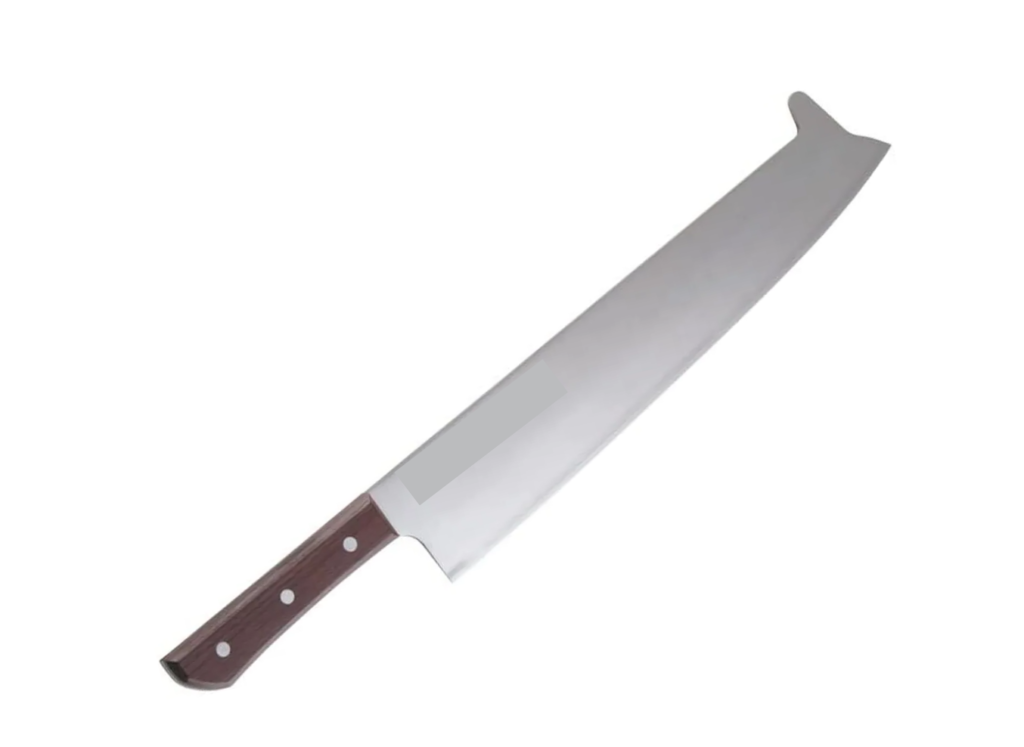
A lesser-known but very handy specialty knife is the frozen food knife (冷凍包丁).
This knife is designed to cut through frozen foods without having to thaw them first. Anyone who’s tried to hack apart a rock-hard frozen block of meat or fish knows it can be a struggle and also dangerous for your regular knives. The frozen food knife tackles this challenge with a design meant for heavy pressure and hard textures.
- Blade Shape: Frozen food knives typically have a broad blade with a very sturdy, thick construction from the base (heel) to the tip. The blade is often long and doesn’t taper much—it stays thick to prevent flexing or snapping under force. A unique feature is that many of these knives have a sort of protruding ridge or knob on the spine (the back of the blade) near the tip. This protrusion is there so you can press down on it with your hand or even a tool to apply extra force. In essence, the knife is built almost like a chisel or splitter, where you might need to push directly down on the spine to drive it through tough material.
- Uses: The frozen food knife’s use-case is straightforward: cutting up rock-hard frozen ingredients while they’re still frozen. Let’s say you have a large frozen slab of meat and you only want to use a portion – a frozen food knife lets you cut that portion off without waiting hours for the whole thing to defrost. It’s great for sectioning frozen steaks, fish fillets, or even splitting frozen burger patties apart. If you freeze food in bulk (like big frozen packs of chicken or beef) and then want to cook it in smaller pieces, this knife is a lifesaver. It’s also useful for things like slicing a chunk of frozen bread or cake (for instance, cutting only what you need from a frozen loaf). Basically, whenever you have a big frozen block that you’d like to break down, this knife steps in.
- Blade Length & Weight: Many frozen food knives have relatively long blades, around 30 cm (12 inches) give or take, to tackle sizable blocks. They are built with plenty of weight and thickness. Compared to your everyday knives, these are heavier. That weight, combined with downward force, helps drive the blade through icy food. Because the tasks often involve pushing straight down (sometimes almost like using an ice pick), the heft is important. The knife feels more like a cross between a kitchen knife and a small cleaver or wedge. It’s definitely heavier than a chef’s knife, which is intentional: you often cut by pressing rather than slicing motions, so you want that mass to help split the frozen item.
- Distinct Feel: Cutting with a frozen food knife is a bit of a workout, but the knife’s design makes it as safe and effective as possible. The thick blade doesn’t bend, so it stays stable as you force it in. You often employ that spine protrusion by pressing your palm on it or even gently hammering it (with a rubber mallet, for example) to push the blade through a stubborn frozen block. This design means you don’t have to wildly hack with a regular knife (which is dangerous and usually ineffective on frozen stuff). Some frozen food knives even have partial serrations or a very toothy edge to help bite into the hard surface, though many rely on sheer sturdiness and sharpness. The key is that they won’t easily slip, and they can take the kind of abuse (twisting, prying) that would likely chip or break a normal knife. Using one feels controlled: you position the blade where you need the cut, apply pressure or tap the spine, and the blade sinks in steadily. It allows you to cut frozen foods safely and reliably, which is a big deal for both home cooks and pros who deal with freezers often.
A frozen food knife might not be as common as the others on this list, but it’s a specialized tool for a very tough job. Its heavy-duty design helps you make use of your freezer stash efficiently—no need to thaw the entire thing when you only want a piece.
For those who frequently cook from frozen ingredients or do bulk meal prep, this knife can be a surprisingly useful addition to the kitchen, ensuring you can portion out frozen foods with minimal hassle and without damaging your everyday knives.
Conclusion
Western style Japanese knives open up a world of versatility, bringing together the finesse of Japanese craftsmanship with the robustness of Western knife designs. Compared to delicate traditional Japanese blades, Western knives are often geared toward more vigorous tasks (think cutting through meat, joints, or even bones) while still maintaining excellent sharpness and control. From the all-purpose gyuto and petty, to specialized knives for carving, boning, or slicing bread, there’s a Western-style knife suited for every need.
The key is to choose the right Western style kitchen knife for your cooking habits. If you primarily cook meats, a sujihiki or honesuki might become your new best friend. Love baking bread? A serrated bread knife is essential. Lots of veggies in your diet? You can’t go wrong with a gyuto or a dedicated yōsaigiri. And if you’re an adventurous cook who tackles whole animals or frozen foods, the heavy hitters like a cleaver or frozen food knife will have your back.
| Feature | Japanese Knives (和包丁) | Western Knives (洋包丁) |
|---|---|---|
| Blade shape | Predominantly single-bevel edge (片刃) | Predominantly double-bevel edge (両刃) |
| Types | Many specialized types for each purpose | Many knives are highly versatile |
| Steel | High-carbon steel for superb sharpness | Often stainless or softer steel |
| Production | Includes traditional honyaki (single steel) and kasumi (laminated) forging methods | Typically forged from a single piece of steel |
| Maintenance | Requires careful upkeep to prevent rust or damage | Less prone to rust, easier day-to-day maintenance |
In the end, having a few quality Western style Japanese knives in your collection will make prep work easier, faster, and more enjoyable. They blend durability with precision, and many home cooks find that using these knives elevates their cooking experience. So go ahead and explore the types above—each knife has its own strengths, and the right one (or combination) can truly transform the way you work in the kitchen. Happy cooking, and enjoy the cutting edge that Japanese craftsmanship brings to Western knife styles!

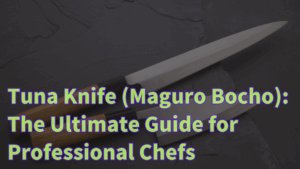
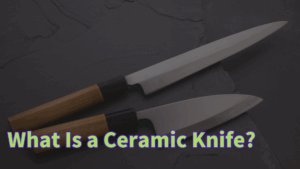

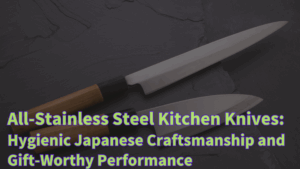
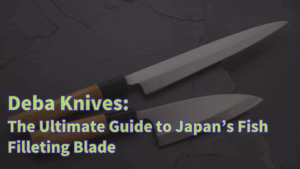



Comments